
The text of the following article appeared in the Summer, 2011 edition of "Rudder."
Lake Geneva's Steam Yachts
With the completion of the Chicago and North-Western Railroad's direct line from Chicago through to Williams Bay in 1871, it was only a short walk across the road from the French Provincial styled train depot to the municipal pier. There the steam yachts waited for the wealthy estate owners arriving on the "Millionaires' Special," the North-Westerns club-car-equipped evening commuter
train. The yachts, with their uniformed captains, glistening varnish, polished brass and rich appointments reminiscent of a French brothel, presented an impressive spectacle. Tooting whistles and clanging bells accompanied their departure, whereupon they often engaged in impromptu races as their owners cruised home to dinner.
But the steamers were more than just water taxis. The steam yacht inevitably became the focal point in this setting because they excelled as association places, a unique venue for elegant assignations, business discussions, social gatherings, and stylish transportation. When Norman Harris' daughter married, friends' steamers transported several hundred wedding guests to the Harris
Estate for the occasion that a contemporary observer described as,
"A festive sight with the boats all lined up, flags flying, and their
captains in dress blues."
The Martin Ryerson's had a red carpet on their pier and entertained such notables as John D. Rockefeller and Theodore Roosevelt as well as many artists, performers, and scientists. Ryerson, a founding trustee of the Chicago Art Institute, was known for his discriminating taste in art. His wife Carrie endowed the Chicago Civic Opera and sponsored a number of aspiring singers.
Hotelier Tracy Drake serenaded guests aboard his yacht with a windup Victrola, his son Carlos recalled: "The lovely quiet dinners we used to enjoy aboard Aloha with the crew forward and ourselves aft listening to Caruso and Farer singing out of the big-horned phonograph--our slowed-down steam engine making hardly any sound, and the yacht gliding along in a path of moonlight on a
perfectly calm lake."
But not everyone was of the same mind. Francis Bewilder recalls: "I loved the steam yachts because I did have enough sense to appreciate
their beauty. But at that youthful time I liked to see them best from
a distance. I usually succeeded in evading the genteelly somnolent
three-hour cruises, but on occasions when I was included I recall
being inserted into white flannel pants and blue jacket for which my
enthusiasm was tepid. Stiffly correct with a capital 'C."
As to the yachts themselves, the earliest ones were built locally
and it was a stretch to call them yachts. They were built of timbers
hand-hewn with an adz and planking from local saw mills, and they
had little in the way of metal fittings, the cleats, chocks, bollards and
such being made of wood. However, the general arrangement of the
cabin and deck space that evolved early with the characteristic engine
room and steering station forward, a small day cabin that contained
a pantry and head in the middle of the boat, and an intimate after
deck for the owner and guests, set the style that remained more or
less constant for the next fifty years.
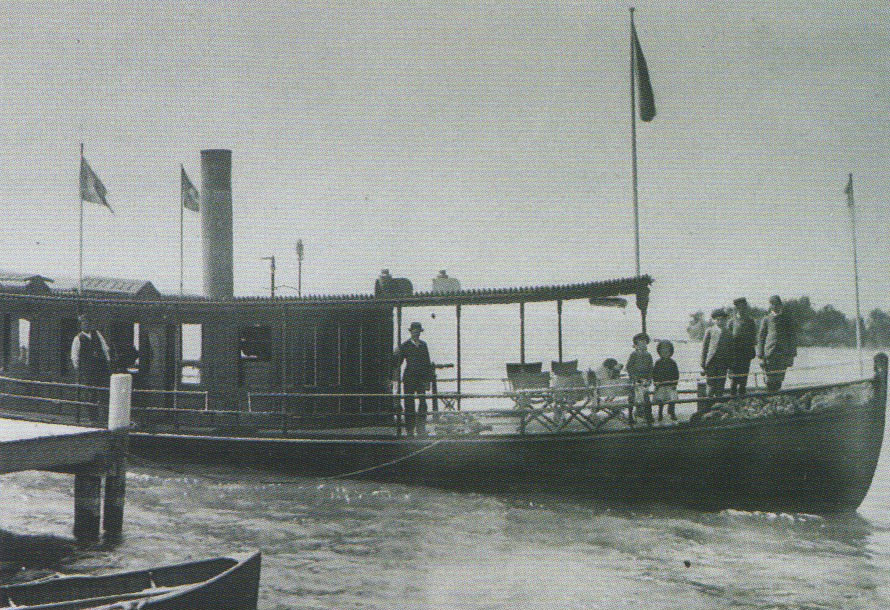
"Mate" William Napper built most of the steam boats during the 1870's and 80's. He was born in Chichester, England, in 1858 and was apprenticed to a shipbuilder at an early age. With a natural aptitude for working in wood, he became highly skilled at the trade. In 1866 he signed on aboard the Great Eastern as Chief Carpenters Mate and was actively involved for three years in laying the Trans Atlantic cable. Quick-witted and deep-voiced "Mate" was widely known as an entertaining yarn-spinner and congenial companion. He kept a short length of trans-Atlantic cable in his shop, and a large hook that was used to retrieve the cable on occasions when it broke, and he never tired of talking about it. Working from drawings by William Bates, an itinerant naval architect from Manitowoc, Wisconsin, "Mate" built a series of robust, attractive vessels for affluent Chicagoans newly settled along the lake shore. Typically they were from 50 to 70 feet in length and were usually painted white or in strong colors such as green or blue, with very little in the way of varnished bright work. They were powered by small one- and two-cylinder low-pressure steam engines developing 50 or so horsepower with steam provided by a wood-fired vertical boiler.
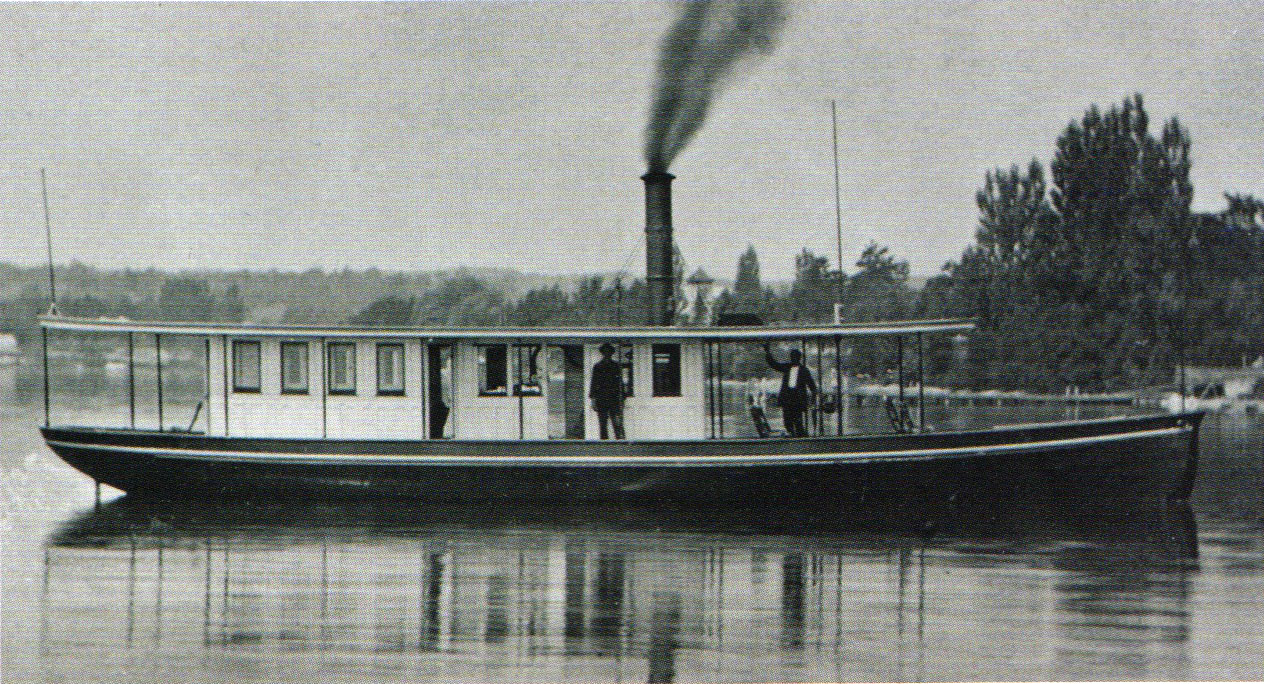
By the 1890, the influx of more affluent lake shore residents produced some good-natured competition for larger and finer vessels and the emphasis shifted to boats with finer woodwork, more detailed trim, and more refined appointments. Along with this was the desire for more horsepower (some things never change) and the boats, now in the yacht category, came with two-cylinder compound engines and eventually with triple-expansion, high-pressure, condensing steam engines that developed up to 200 horsepower. Steam for these engines was now supplied by water-tube horizontal boilers that burned hard coal. The Ryerson yacht, Hathor, when launched in 1898, was described in the local newspaper: "The Ryerson's $30,000 steam yacht is a glory of mahogany with brass and silver fittings. The roomy cabin is finished in mahogany and handsomely fitted up with lounges, sideboards and other conveniences of the modern pleasure boat, having great crimson silk cushions bearing the name Hathor woven in to the fabric, and a complete electric system installed at a cost of over $1,000. The Hathor is seventy-three feet in length, built with a flush deck, and draws four feet of water. lt has a triple expansion engine of sufficient power to give a lively brush to some of the older boats on the lake, but whether there will be any rivalry in this line remains to be seen."
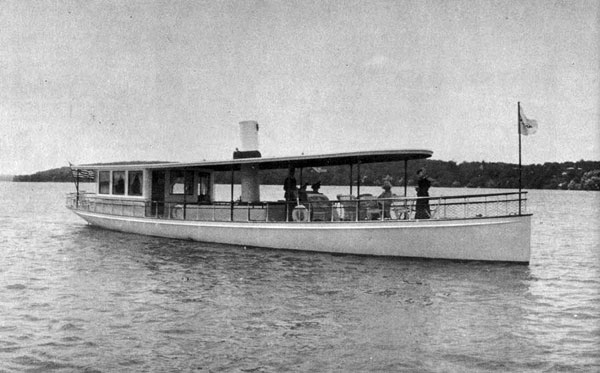
Ryerson yacht Hathor -- launched in 1898 Because of the relative sophistication of these yachts, they were beyond the ability of local craftsman and most were built in Racine, Wisconsin, by the Racine Boat Manufacturing Company or in Chicago by Great Lakes Shipbuilding Co. They were transported to Lake Geneva by rail using a flat car that had been specially built by Allis-Chalmers Co. to transport large pieces of farm equipment and heavy electrical machinery and was used by the boat builders when needed. The railroad track ran along the lake shore in Williams Bay, about a hundred feet from the lake, between the train station and the round house. There the yachts were unloaded sideways and slid into the lake on greased timbers, a process that usually took a week. The yachts were now made of riveted steel plates, their length increased to 70-90 feet, and the displacement rose to 40 tons in the larger boats. Many of these yachts were designed by naval architect George Warrington who Theodore Roosevelt would later name Director of Lighthouses and Lightships for the United States Coast Guard. These vessels were models of naval architecture with smooth, graceful sheer lines complimented by tasteful proportions. Brass hand rails and fittings, polished to a mirror-like finish, abounded throughout the elegantly appointed craft. Electric light fixtures illuminated the cabin interior and were also hung like Japanese lanterns along the edge of the canopy. The decks were bleached-white, holystoned, and lined with glistening varnished mahogany covering boards. Clipper bows with towering masts began to appear. The Racine Boat Company catalog published in 1900 describes one of their boats: "This steam yacht is of our own creation being built for pleasure purposes on Lake Geneva. It is constructed entirely of steel with five watertight compartments. The machinery consists of a Racine water tube boiler and one of our 6, 10, & 16 x 9-inch stroke triple expansion engines developng 200 indicated horsepower giving a speed of 15 miles per hour. Mahogany finish throughout; electric lights and modern conveniences. Very beautiful, speedy, safe, economical craft that will meet the views of the most fastidious in every particular." By 1910, the steam engine had passed its apogee. The last two Lake Geneva yachts were built in 1911 and 1913 by the Gas Engine & Power Company and Charles L. Seabury, Consolidated, in New York City, which shortly thereafter became Consolidated Shipbuilding. These boats came with a higher level of appointments--beveled glass windows with Belgium lace curtains, nautical creatures hand-carved in the mahogany paneling, oriental carpets, silver plated fittings in the head and galley--but they were now powered by Speedway gasoline engines, and one of the boats had two such engines.
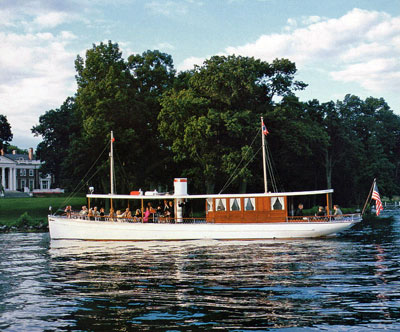
|
 From the 1870s through the 1920s, dozens of elegant steam powered yachts gilded like graceful swans across the surface of Lake Geneva. Their owners would entertain guests, pick up friends for an afternoon of golf at the country club, transport weekend visitors from the train depot to the lake shore estate or simply enjoy a scenic cruise. Often a quiet buffet supper would be served on the after deck as the beauty of the day climaxed in a gloriously colorful sunset. It was an era of serene and ample elegance in which Lake Geneva's golden age evolved and flourished.
From the 1870s through the 1920s, dozens of elegant steam powered yachts gilded like graceful swans across the surface of Lake Geneva. Their owners would entertain guests, pick up friends for an afternoon of golf at the country club, transport weekend visitors from the train depot to the lake shore estate or simply enjoy a scenic cruise. Often a quiet buffet supper would be served on the after deck as the beauty of the day climaxed in a gloriously colorful sunset. It was an era of serene and ample elegance in which Lake Geneva's golden age evolved and flourished.
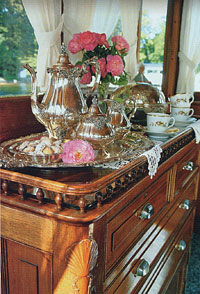 Sadly, this period of beauty and serenity was destined to end. The Great Depression sent most of the remaining steam yachts into storage and the use-tax of World War II kept them there. A few were cut up for scrap for the war effort, others were burned, one still having coal in its bunkers and ready to launch but without an owner who could afford to use it. Because of their age, their rarity, the uniqueness of this particular design to Lake Geneva, and because of the role
the boats and their owners played in the lifestyle of early Lake Geneva, the boats are historically important and worthy of preservation. Today, only five of these yachts remain in their original form, painstakingly maintained by their dedicated owners.
Sadly, this period of beauty and serenity was destined to end. The Great Depression sent most of the remaining steam yachts into storage and the use-tax of World War II kept them there. A few were cut up for scrap for the war effort, others were burned, one still having coal in its bunkers and ready to launch but without an owner who could afford to use it. Because of their age, their rarity, the uniqueness of this particular design to Lake Geneva, and because of the role
the boats and their owners played in the lifestyle of early Lake Geneva, the boats are historically important and worthy of preservation. Today, only five of these yachts remain in their original form, painstakingly maintained by their dedicated owners.
